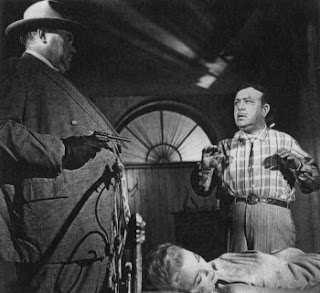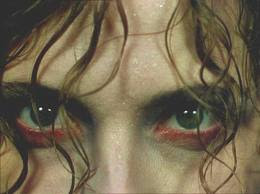As American an art form as jazz, Film Noir sprung out of the national angst surrounding World War II. And like the syncopated rhythmic music developed by black and Creole musicians and first heard on the streets of New Orleans at the turn of the 20th Century, noir films blended existing artistic motifs and slapped in generous doses of improvisation and cynicism to become a new cinematic language or genre that would affect film-makers across the globe.
Its heyday was an approximate fifteen-year stretch starting in the early 1940s. The term film noir, meaning "black film," was coined by French critic Nino Frank in 1946 as applied to Hollywood movies of the period. Its roots can be found in American crime novels of the Depression era and German Expressionist cinema of the 1920s.
Though the visual style might vary, its most consistent characteristic was stark, distinctive high-contrast lighting in black-and-white photography, laden with deep shadows and menace. Its citizens were mostly low-rungers: desperate small-time hoods, beat cops, waitresses, lonely saps and loners, and most famously, femme fatales, gals out to move up a rung or two, anyway they could. Along the way the audience is sure to get a good hard look at society's underbelly.
 |
| Sunglasses can't disguise Barbara Stanwyk's duplicitous Phyllis Dietrichson. |
Noir icon and champion chump, Robert Mitchum, falls in love with the wrong woman in Jacques Tourneur's Out of the Past (1947), a tale of a detective unable to escape a past mistake. He has a choice, but he can't help turning his back on the good, sensible girl who loves him. Featuring Jane Greer as the twisted object of his affections, and Kirk Douglas as his gangster nemesis, the film contains characteristic voice-over dialog. Some of the best reveals the depths of Mitchum's obsession. "I went to Pablo's that night. I knew I'd go there every night until she showed up. I knew she knew it. I sat there and I drank bourbon and I shut my eyes, but I didn't think of a joint on 56th Street. I knew where I was and what I was doing. What a sucker I was."
Mitchum had bad luck with cars in noirs. When Greer's character realizes he is driving them toward a police barricade, she shoots him dead before police machine gunfire shatters the windshield. Six years later, in director Otto Preminger's Angel Face, dreamy but dangerous Jean Simmons backs him up over a cliff.
Mitchum wasn't the only sap to fall victim to an enticing beauty. Edward G. Robinson starred in two films by German-born director Fritz Lang: The Woman in the Window (1944) and Scarlett Street (1945). In each he is mild-mannered, middle-aged, and a little dumpy. If it occurs to him that it is odd that the beautiful Joan Bennett seems attracted to him, he pushes it out of his mind--he is infatuated. Both films have the relationship leading to run-ins with Dan Duryea and murder. Duryea, a fixture in many noirs, had a sniveling demeanor and could curl his lip in a sneer with the best of them.
 |
| Edward G. Robinson can't resist the beautiful Joan Bennett. |
The quintessential heist movie is The Asphalt Jungle (1950). Directed by John Houston and set in Cincinnati, it features a band of small-time crooks, more pathetic than sinister. These are just guys looking for a break in life: Doc Reidenschneider (Sam Jaffe), the recently paroled mastermind hoping for one last big score; Dix Handley (Sterling Hayden), the muscle with a dream of owning a horse farm; Louie Ciavelli (Anthony Caruso), the safe cracker whose wife and kids live in a cramped tenement; and Gus (James Whitmore), the getaway car driver who owns a greasy-spoon.
Noir crime doesn't pay and you can often expect a double-cross. The band comes up against one when, after securing the gems, their fence, dishonest attorney Alonzo Emmerich (Louis Calhern), fails to deliver the payout as promised. Shots are fired and the band disperses to their respective fates: arrest, suicide, and death.
The Asphalt Jungle inspired numerous copy-cats, and to demonstrate its influence overseas, director Jules Dassin produced the similarly constructed Rififi, a stylish 1955 French thriller.
 |
| Comely Marilyn Monroe was introduced to America in The Asphalt Jungle. |
Director Henry Hathaway pushed the violence envelope to a sick level to show that something stank in post-war American society. If we had defeated Hitler and Tojo in Europe and Asia, we had still failed to eradicate corruption, poverty, and malaise in our own cities. In Kiss of Death (1947) Richard Widmark burst onto screens as Tommy Udo, one of Noir's most demented characters. In one memorable scene, he laughs maniacally as he lashes a woman to her wheelchair and sends her bouncing down a flight of stairs, first taunting her, "You know what I do to squealers? I let 'em have it in the belly, so they can roll around for a long time thinkin' it over. You're worse than him, tellin' me he's comin' back. Ya lyin' old hag!"
 |
| Tommy Udo helps a lady down the stairs. |
Udo wasn't the only psychopath loitering in movie houses that year. Robert Wise's Born to Kill showed that depravity wasn't restricted to the low and middle class. It featured Lawrence Tierney as the appropriately named Sam Wild, a man without a conscious or morals, and whose liaison with a wealthy socialite out to grab her sister's money is no bargain for either. Claire Trevor played the woman, who one character describes as "the coldest iceberg of a woman I ever saw, and the rottenest inside. I've seen plenty, too. I wouldn't trade places with you if they sliced me into little pieces."
 |
| Lawrence Tierney and Claire Trevor form an unholy alliance in Born to Kill. |
Ten years later we had made little progress in fixing our problems. They might be covered in a veneer of shiny new refrigerators, green suburbs, cars with power-steering (Chrysler's Hydraguide), and that most sought-after creature comfort, television; but they were alive and well.
No film shined a light under the veneer with better acuity and sharpness than Sweet Smell of Success (1958) by Alexander Mackendrick. The story plays out in the tony clubs and restaurants of Broadway and Times Square, and on the dark, crowded, and wet streets of New York. It's a wonderfully shot film by famed cameraman James Wong Howe in gritty black and white, helped immensely by Elmer Bernstein's tense jazz score--you can almost smell the cigarette smoke and garbage cans, and feel hot sweat running down people's backs in the jostling street venders and crowds. It is a fascinating look at how the media can peddle scandal and insinuation to titillate readers. You can't help but peek.
 |
| "Match me, Sidney." |
Tony Curtis and Burt Lancaster star, Curtis as Sidney Falco, a lapdog press agent who "wants to get way up high, where it's always balmy;" and Lancaster as powerful columnist J. J. Hunsecker. Their relationship, rotten and symbiotic, is the heart of the film.
Happiness is an elusive dream in Film Noir. The genre attracted some of the best Hollywood directors and actors. Film-maker Nicholas Ray fashioned a tense drama from Dorothy Hughes' pulp novel, In a Lonely Place (1950), where the dark soul of a man in on view in all its ugliness. The requisite atmospheric lighting and shadows are here, along with melodramatic music and as flawed a protagonist as ever trod the genre. Dixon Steele (Humphrey Bogart) is a paranoid writer, beset by inner demons and a wild temper. When falsely accused of murder and hounded by the police, he slowly unravels and cracks under the pressure until he risks losing the woman he loves. He sees it happening and that makes his inability to control his emotions and behavior that much more affecting.
 |
| "I was born when she kissed me. I died when she left me. I lived a few weeks when she loved me." |
Like most noirs, you know it won't end happily. The final scene is gripping as Steele confronts Laura Grey (Gloria Grahame) in her apartment, believing she has betrayed him. He finally goes too far and Bogart sags a broken man. You can't help but feel sorry for him. He came so close.
Noir characters often face moral conflicts. In Otto Preminger's Where the Sidewalk Ends (1950) police Mark Dixon (Dana Andrews) lets his penchant for excessive use-of-force box him in a corner. His victim, a low-life hood, doesn't matter, but Dixon's plan to cover up a likely manslaughter charge goes awry when his actions put an innocent man under suspicion. That he happens to be the father of the girl Dixon has fallen in love with makes matters even more difficult. Does he confess the crime, face expulsion from the police force and jail time, or keep quiet and win the girl of his dreams? The dilemma leaves the officer at a loss. His lament, "Where the devil am I? I keep coming and going," mirrored the state of confusion America sometime found itself in in dealing with societal woes in the post-war era.
Preminger had earlier cast Andrews as a policeman in Laura (1944), one of the genre's most celebrated efforts. Here, while investigating the killing of Laura (Gene Tierney), Andrews falls in love with the girl's memory, helped along by her striking painting. In a surprise twist, Laura turns up alive. It is an innocent friend who was murdered by mistake.
 |
| Dana Andrews has a strange attraction to a portrait of a dead girl. |
Noir films petered out at the end of the 1950s as film-makers and American audiences grew tired of the genre. Westerns had taken over on TV, and technicolor epics were the new darlings of cinema. One of the last noirs was one of the best, Orson Welles' sordid Touch of Evil (1958), which depicted corruption in a Texas border town.
Welles played Hank Quinlan, a corpulent policeman not above planting evidence to secure a conviction. "I've never framed anyone," he says, "...unless they're guilty."
Welles infused his film with his signature camera magic: Extended takes, jarring angles, and uncomfortable close-ups. Like the genre itself, Quinlan comes to an abrupt end, floating in a pool of fetid water. It is a fine and fitting death.
 |
| In Touch of Evil Uncle Joe Grande is no match for Hank Quinlan. |





.png)















